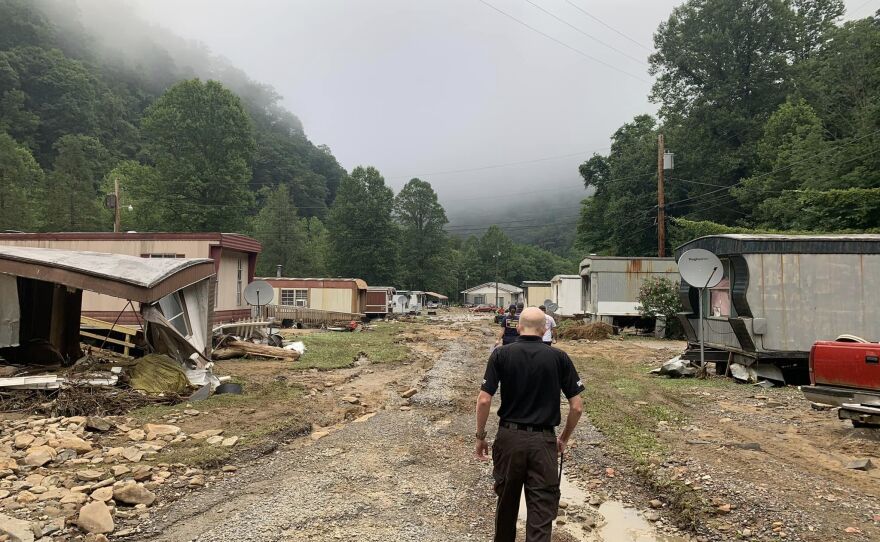Virginia communities have been deeply affected by flooding in the past and in recent years. The commonwealth has also seen an increase in risk for flash flooding and landslides. A study by researchers at Climate Central has predicted that Virginia could lose 42% of tidal wetlands to sea level rise by 2100.
Flooding is destructive to the natural environment and for people. Not only is flooding the most common and costly natural disaster, but it is also extremely dangerous. According to the National Oceanic and Atmospheric Administration, 88 people die from flooding across the U.S. each year on average, surpassing deaths from tornadoes, hurricanes and lightning.
On Aug. 19, 1969, Hurricane Camille dropped 30 inches of rain in Nelson County. Virginians were unprepared for this disaster as forecasters had no idea it was coming.
“You have rainfall falling — an intense amount of rainfall falling on very steep topography, so it's already going to be running off very quickly. [It was] happening overnight, so everybody was taken by surprise,” said Jeremy Hoffman, the David and Jane Cohn scientist at the Science Museum of Virginia. “Unfortunately, over the course of the whole storm, I think over 120 people wound up losing their lives in Virginia alone.”
Hurricane Camille is one of only four Category 5 hurricanes to ever make landfall in the United States.
Hoffman said Hurricane Camille’s strength will always be a bit of mystery.
“We actually don't know the top sustained wind speeds from Hurricane Camille simply because it destroyed all of the wind recording equipment in the landfall area,” Hoffman said. “We kind of rely on back calculating what was probably the condition to get its maximum sustained speeds.”
Hoffman said hurricanes like Camille as well as Agnes (1972) and Gaston (2004) are seared into the collective cultural memory of Virginians because of their devastating impacts.
“In historical discussions of flooding, we tend to focus on hurricanes. But now, the story is more, in recent memory, it's these really intense, short, non-tropical storms, causing a comparable level of devastation in communities around Virginia, particularly in Buchanan and Tazewell counties,” Hoffman said.
In July 2022, Buchanan County flooded. The flash flooding washed away and damaged homes. On top of the destruction, 44 people went missing, swept away by floodwaters and mudslides. Goldie Looney, who lives in nearby Tazewell County, watched helplessly as the river in her backyard overflowed, flooding her home. Her cousin was one of the reported missing persons.
“Her car actually had got mudslided. And the family was worried, didn't know where she was at. But we found out she had [gone] to a neighbor's house. So, she was good. But there's other people that were missing, that it took days to find,” Looney said.
Additional help arrived in Buchanan County when Gov. Glenn Youngkin declared a state of emergency. As rescue teams from across Southwest and Central Virginia pitched in, they were able to find all the missing people and bring them to safety.
The Virginia Department of Emergency Management helped manage search and rescue teams and had a public information officer on scene to help deliver vital information to the public.
“All disasters are going to have the first responders from that specific locality respond to that disaster. And then when the state steps in, that's really when those localities have identified the need,” said Katie Carter, VDEM’s community impact manager.
VDEM is still assisting the county with recovery efforts, such as helping the county with FEMA reimbursement and with mitigation projects.
Looney said Buchanan County and the surrounding areas have yet to recover.
“They're not cleaned up there. Their houses are gone, their homes, their things. And you wonder, if that's you, what would you do? And every flood comes, you got that fear left,” Looney said.
The Clinch River, which flows southwest through the Great Appalachian Valley and through Looney’s backyard, continues to flood and impact her livelihood.
“It's an everyday thing. When it floods in our basement, we [have] to replace that hot water tank. [My] garden, it's gone. We've had a pond that I've had for over years, it's gone. My car it's gone. It's just not there anymore,” Looney said. “And you just fear, you have to get your car out before it [the flood] gets to your driveway, or you don't have a car. You have no way out then.”
What Looney and her neighbors endured is called sudden catastrophic flooding. More Virginia cities are dealing with flash flooding of varied intensity as storms become more frequent and more powerful.
In Old Town Alexandria, the Potomac River is rising more frequently. The city’s stormwater project manager, Dan Medina said that with nothing to block the water, it’s getting into the drainage system and flooding the streets, creating a chronic problem.
“If we were standing here during what is called King Tide, which is one of those extreme events of the year, we'd probably be pretty much underwater,” Medina said.
The city is considering a variety of solutions — from barriers to drainage system upgrades, at a cost of tens of millions of dollars.
The Hampton Roads area has endured similar street flooding to Alexandria, but coastal communities are also dealing with the challenges of sea level rise. Climate experts say part of the problem is that the land is also sinking.
At Old Dominion University, researchers are building a “digital twin” (a virtual model of a physical object) of Hampton Roads using Geographical Information Systems, which is a digital version of maps. ODU Geography Professor Tom Allen said the digital twin is like having a time machine.
“In our digital twin, we can simulate flooding in the future, assess the impacts, and redesign to reduce the effects or the hazards, economic costs for example, of those,” Allen said. “So, it's a way of using it to look into the future.”
The digital twin benefits the Hampton Roads area and localities across Virginia that know all too well what flooding can do.
“We're going to develop a prototype, think of it as a demonstration and that will be tackling very common issues. A flood event. How does emergency response prepare and respond to a flood event? Well, we would rather train and simulate that, than wait and see and do our experiments in real time,” Allen said.
Hoffman said now is the time to make decisions that will impact the future of Virginia communities, whether that’s using a digital twin, changing a roof to a green roof, building more parks or even de-paving parking lots.
Watch VPM News Focal Point, Thursdays at 8 p.m., on VPM PBS or on the PBS App.



